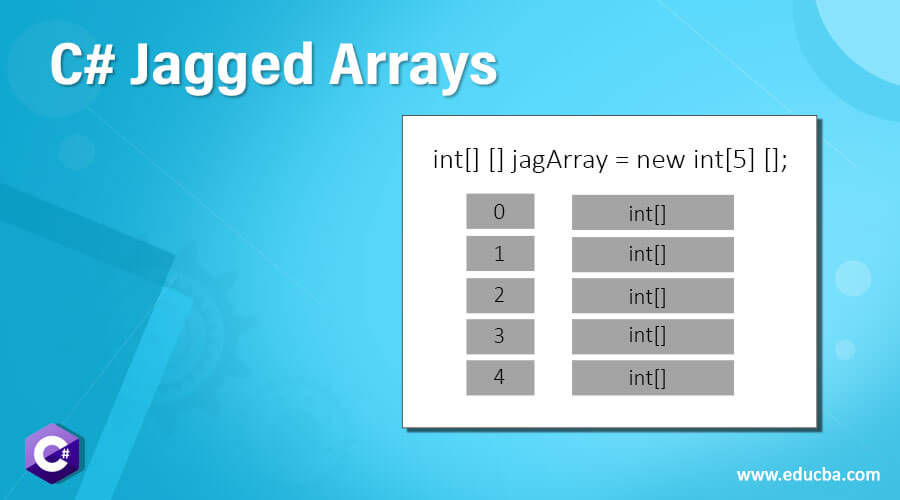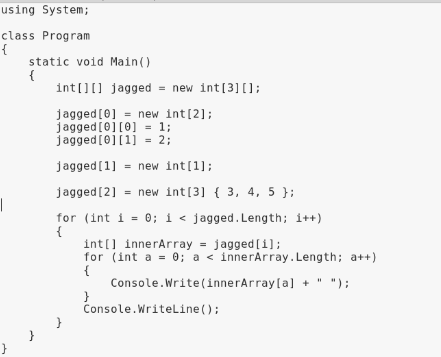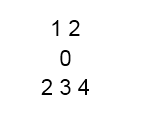Updated July 4, 2023

Introduction to C# Jagged Arrays
The high-level programming languages provide us with several options that are considered very useful while developing the applications. In some of the languages, the programmer is required to write the logic for everything, but in a programming language like python, it is a plus point that there are many inbuilt functions are available. The functionalities provided by the high-level programming languages are used very often while developing modern web applications that need a lot of features. One of the very important features of high-level languages is arrays that let us store the same data type values. Here in this article, we are going to learn about the particular kind of array that enhances the ability of high-level languages. We will be using the C# to implement the jagged array here.
What are Jagged Arrays?
- Jagged arrays may be defined as the multidimensional array that is capable of storing various values under the name of a single variable. The jagged arrays are very helpful in enhancing the capabilities of the applications by letting them process several values stored in a specific manner. The values stored in the jagged array have to be of the same data type, and it is a common standard in all of the high-level programming languages.
- In order to develop an algorithm that needs an operation to be done in the way it is done in the matrix, the jagged array providers use the best platform to do so. Thus, it is beneficial while working with complex algorithms. In other terms, jagged arrays may also be considered a special kind of array that lets the developers store the values in a sophisticated manner to be operated to generate the required output.
- There are several benefits of using jagged arrays. One of the most crucial advantages is that it makes things easy where there is a need to store data in a multidimensional way using the same variable name. Furthermore, it helps in memory management which makes the program to be executed very smoothly and fast as well. In actual terms, it provides efficiency to the program to enjoy the advantages of using the efficiently developed application.
Syntax of Jagged Array in C#
To use any of the features provided by the high-level language or any kind of programming language, it is very important to learn how it has to be written in the program, which we call the syntax. In the same way, a jagged array in C# also has a particular array that we will be discussed here.
datatype[][] variableName = new datatype[rows][columns]In the mentioned above, the data type is present to make sure that which type of data has to be stored in the array. For instance, if the array is supposed to store the integer values, then in that case, the data types have to be int. The variable name is the name of the array that will be used while using the array to get the values stored in it. It can be any arbitrary name that should usually be a character or a string. New is the keyword that is used to create a new array. After the new keyword, the data type mentioned there followed by the number of rows and columns that the array should consist of. For instance, writing int[2][3] means that the array will be containing a total of 6 values, and there will be two rows and three columns.
How to Declare Jagged Arrays in C#?
Before the values can be stored in the array or the array can be used in the program, it is very important to declare it. In order to declare the jagged array, we will be using the same syntax that we have discussed in the last section. Below is an example of how the jagged array can be declared.
Int a = new int[2][4]Here, the variable name or the array name is ‘a’ that is supposed to store only the integer values. The total number of values it can store or hold is 8. The data will be stored in the way as it does in a matrix. There will be two rows, and the number of columns will be 4. As the data type is int, we cannot store the values of other data types in this array.
How to Initialize Jagged Arrays in C#?
After the jagged array has been declared, it is very important to initialize it as we cannot actually use it before initialization. Initialization refers to the process of assigning values to the array or any variable so that it could be used whenever required. We have already declared the jagged array in the last section, and now it turns to initialize that. Below is the way it could be initialized.
a[0][0] = 4
a[0][1] = 4
a[0][2] = 4
a[0][3] = 4
a[1][0] = 4
a[1][1] = 4
a[1][2] = 4
a[1][3] = 4
By using this approach, the jagged array can be initialized. Let it understand with the help of the above-mentioned example. As we know that the jagged array stores the data in the form of the matrix. Let’s consider, a[0][0] for our understanding. Here ‘a’ is the variable name or the name of the array, while the numbers written next to it denotes the number of row and column that will be actually storing the value. When we write [0][0], the value will be stored in the first row and the first column, which is where the value enters first when filled serially in a matrix.
Example
Here we will use a real example to understand how the jagged array can be used properly in order to develop the program. It is important to ensure that while writing the program, one should manage the proper indentation to mitigate the complexity of the program. Below is the snap of the program.

Output:

Conclusion
The jagged array is the most important part of the high-level programming language that lets us store the values in a convenient way. It is very useful while writing the programs or algorithms that have to deal with lots of data that has to be stored in a particular manner. It is very useful in memory management as it just uses a single variable name to store multiple data. It is considered the best practice of programming to use an array instead of various variables. It makes the program very light and plays a vital role in memory management.
Recommended Article
This is a guide to C# Jagged Arrays. Here we discuss the particular kind of array that enhances high-level languages’ ability with initialization and appropriate examples. You can also go through our other suggested articles to learn more –


